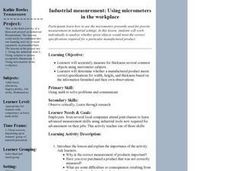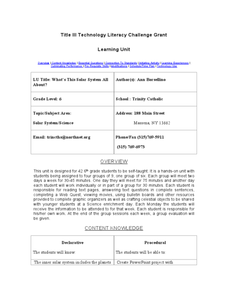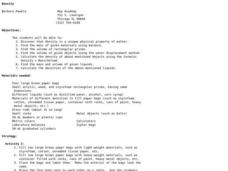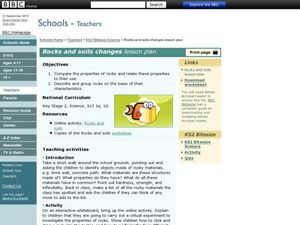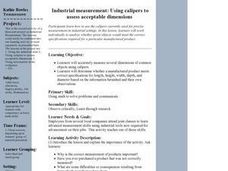Curated OER
Industrial Measurement: Using Micrometers in the Workplace
Students accurately measure several common objects for thickness using micrometer calipers. They work individually to analyze whether given objects would meet the correct specifications required for a particular manufactured product.
Curated OER
I've Got That Sinking Feeling
Young scholars design a simple boat and predict how much weight it can carry. They should also discover why objects float or sink and how this can be determined experimentally. A great lesson on buoyancy!
Curated OER
What's This Solar System All About?
Sixth graders complete a unit of lessons on the solar system. In small groups, they participate in a Webquest, watch movies, complete graphic organizers, and answer questions, create a model of the planets, and develop a Powerpoint...
Curated OER
Dichotomous Key
Middle schoolers draw comparisons between organisms. They classify organisms. Students are introduced to dichotomous keys and how to create and use a dichotomous key to identify a variety of objects. They begin by defining...
Curated OER
The Great Spoon Challenge: Form and Function
Students organize objects in terms of form and function. In this architecture lesson, students are introduced to the ideas of form and function by playing a game in which they organize spoons in different ways. Extension activities are...
Curated OER
Density
Students find the mass, volume, and density of various objects. In this density measurement lesson, students observe how same-sized objects can have different masses, then use water displacement to find the density of each object and...
Curated OER
Jungle Gym Drop
Students investigate gravity, force and motion. In this motion of objects lesson, students drop various objects from a jungle gym and collect, measure and observe their data. Students describe the forces that affect the motion of their...
Curated OER
Living or Non-Living
Students examine living and non-living things. In this life science lesson plan, students are given a group of objects and discuss if they are living or non-living. Students identify and list characteristics of living things.
Curated OER
What's in the Sock?
Second graders use their sense of touch to identify a variety of objects. In this sense of touch instructional activity, 2nd graders listen to a read aloud of Sandra Boynyon's, Fuzzy Fuzzy, Fuzzy. They talk about different textures and...
Curated OER
Rocks and Soil Changes lesson plan
Students recognize objects around their school made of rocky materials. In this changes in rocks and soil lesson, students use a website for a virtual experiment of rocks. Students group rocks based on their properties....
Curated OER
Wetland in a Pan
Seventh graders build a watershed from various materials. In this life science lesson plan, the students will be able to change the design of their watershed to see the changes in the way the water will drain. Each group will be able to...
Curated OER
You’re Tugging at Me!
Students study the sliding and rolling friction. In this forces lesson plan students divide into groups and use a cart to examine the amount of force that is used to move objects.
Curated OER
Speedy Trials
Fifth graders investigate how forces affect the motion of an object. In this physics lesson, 5th graders calculate an object's speed using a mathematical formula. They discuss how force and mass affects the speed.
Curated OER
The Physics of the Planets: How 16th and 17th Century Physicist Helped Us Understand Our Solar System
Eighth graders draw the paths of the planets in the solar system. In this astronomy lesson, 8th graders calculate speed of objects using distance and time information. They research about the work of scientists in the 16th and 17th century.
Curated OER
Catch Comparison
Students compare the differences in catching four different pieces of equipment. They, in groups, practice catching the items, and discuss which one was the easiest and hardest to catch, and graph their results.
Curated OER
A Taste of Our Classroom
Students explore their classroom tastes. In this lesson plan, students list the four tastes that the tongue can detect, map the individual areas of taste on the tongue, and demonstrate the ability to identify objects through the use of...
Curated OER
Artifact Classification
In this artifact classification activity, students are given a list of key terms and two activity sheets about classifying artifacts of the Pee Dee culture. Students analyze artifacts and group them to answer questions on the...
Curated OER
Identifying Musical Instruments
First graders identify different musical instruments. In this music appreciation lesson, 1st graders discover the different groups and sounds of instruments while learning their names as well. Students write about an...
Curated OER
The Adventures of Mr. Toss
Young scholars practice with the underhand toss in a fun culminating activity. First, 4-5 students make a circle. All circles should be close enough to the instructor to easily hear the story. Explain that each group be given an object...
Curated OER
Industrial Measurement: Using Calipers to Assess Acceptable Dimensions
Students accurately measure several dimensions of common objects using calipers. They determine whether a manufactured product meets correct specifications for length, width, height, depth and diameter.
Curated OER
Ready, Set, Go!
Students predict if the height of a ramp affect how far an object travels. They design and conduct an experiment to test their predictions. The results are recorded and a graph is created to show the relationship between ramp height and...
Curated OER
What Floats Your Boat?
Middle schoolers are introduced to the concept of buoyancy. The Video used in this instructional activity demonstrates and explains the characteristics of objects that sink and float. It presents the concepts of displacement, weight, and...
Curated OER
Understanding Fractions
Students explore the parts of an orange to develop an understanding of the addition and subtraction of fractions. The concept of representing parts of a whole by dividing an object into smaller pieces is experienced in this hands-on...
Curated OER
Can You Afford to Retire?
Learners participate in a game in which one group acts as the company and the other group acts as the employees. They examine what happens when the company files for bankruptcy. They discover labor strategies as well.


